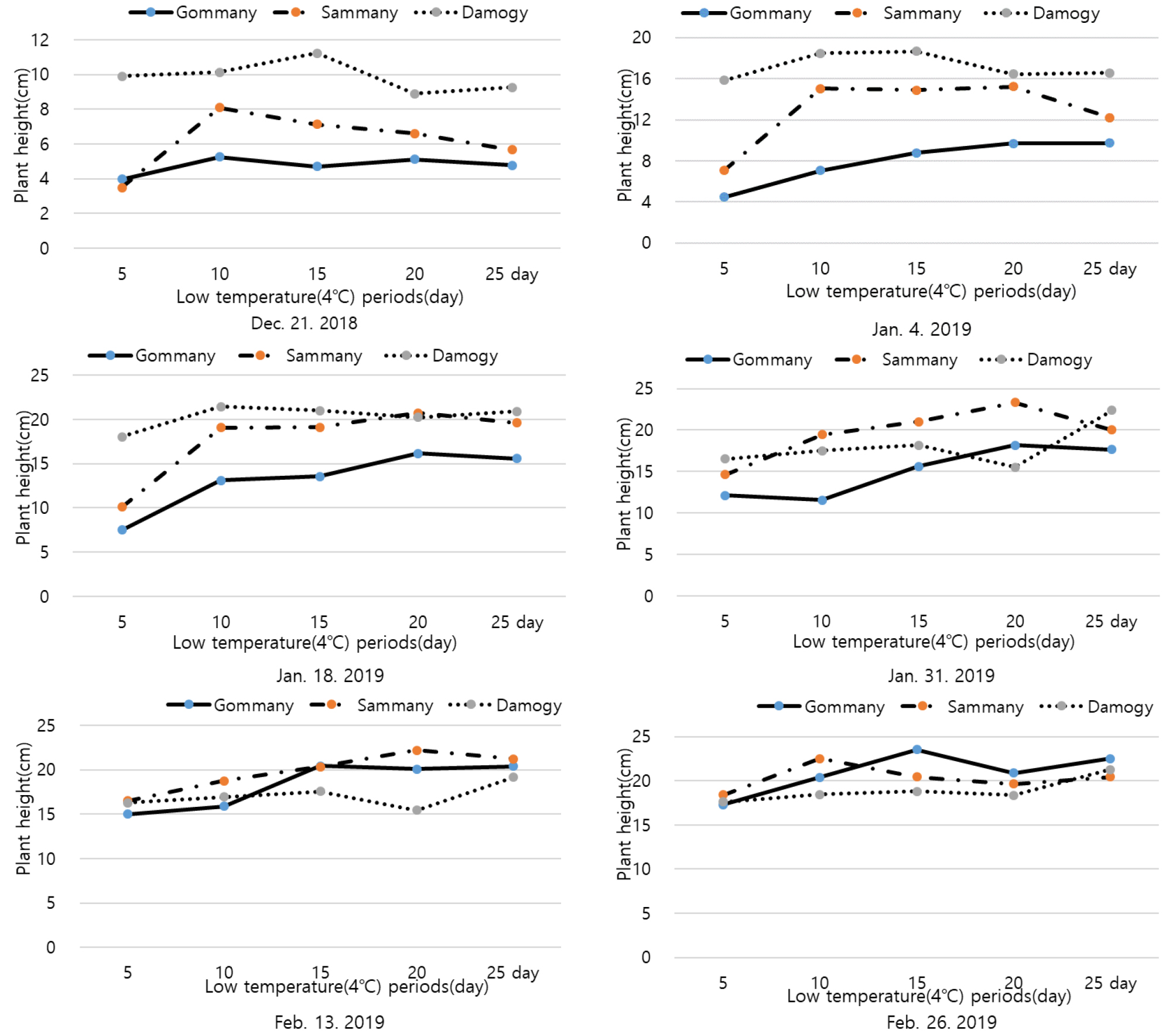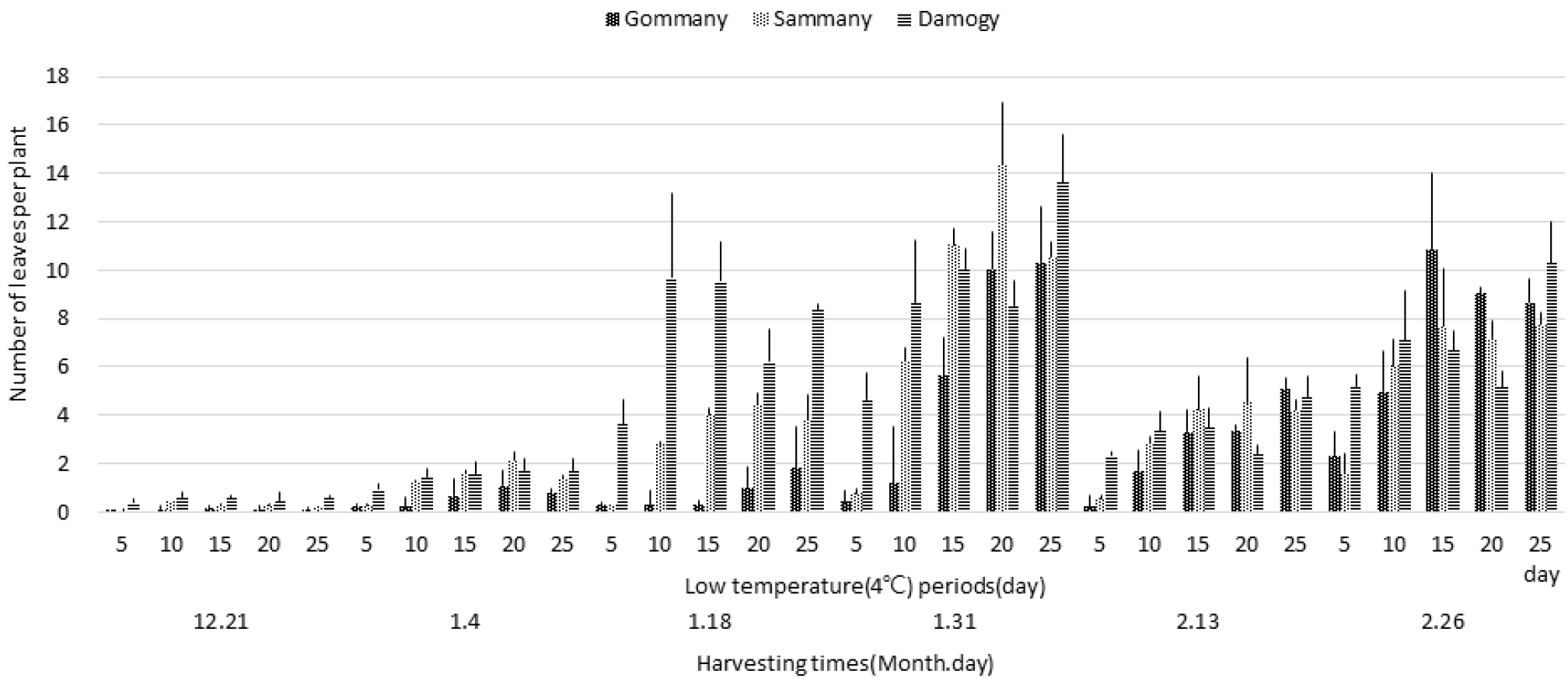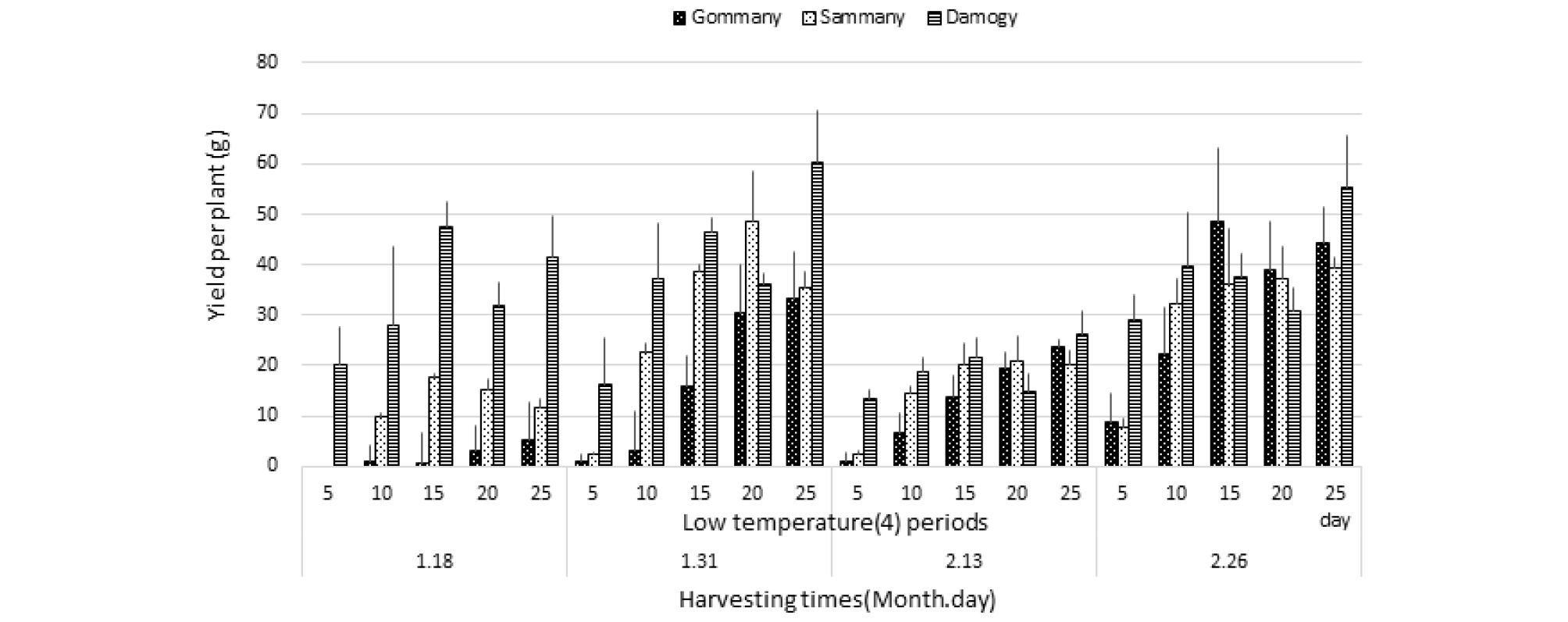Introduction
Gomchwi (Ligularia fischeri (Ledeb.) Turcz.) is perennial plant grown nationwide in Korea. Gomchwi leaves are consumed either fresh or boiled. It is also dried and stored for later use. Gomchwi has been recognized as a good source of nutrition because of its antioxidant content and the various forms of vitamins and minerals it provides (Cho and Kim, 2005). Currently, in order to have fresh produce of January and February, Gomchwi or Gondalbi is planted in the water screen house during the months of August and September. Then, it is warmed in December, and harvested in late January or early February of the following year. Gomchwi or Gondalbi is a perennial plant which experiences dormancy during the winter season. Thus, it is necessary to break its dormancy in order to begin spear germination in forced culture. Dormancy of Gomchwi is usually stopped after being exposed to temperatures below 5℃ for more than 360 hours (Suh et al., 1996). There are many other crops that require a temperature lower than 5℃ to break its dormancy. For example, asparagus’ dormancy was broken using the following low temperature treatments: 5℃ or less for 1,000-1,250 hours in field of Jeju island area, and 5℃ for 504 hours in cold storage (Seong et al., 2002). The cold treatment period had positive effects on breaking the dormancy, promoting growth rate, and in increasing the yield of Asparagus (Lee et al., 2013). The recommended date of applying heating treatment is November 15 in order to have an increase in the quantity and quality of asparagus under plastic film house condition in the Jeju island area. In the forcing culture of asparagus, January 10 is the most desirable date for optimum heating (Seong et al., 2012). Yoo and Bae (1998) reported that cold treatments at 3℃ for 50 to 70 days and 5℃ for 60-70 days were used to break the dormancy for early production of young leaf in Butterbur (Petasites japonicas MAX.). In Udo (Aralia cordat THUNB.), the accumulated low temperature time of less than 5℃ is 720 hours (Yoo et al., 2000). For winter production of Primula sieboldii P. modesta var. fauriae and Disporum smilacinum, their dormancy was broken at a low temperature of 5℃ for 500 to 700 hours or more and then moved to a greenhouse to produce flower pot in the first week of February (Suh et al., 2006). Since Gomchwi is cultivated in the same days, it is important to find a method for breaking the dormancy of its new varieties, Gommany (Suh et al., 2016), Damogy (Suh et al., 2017) and Sammany (Suh et al., 2018), for the winter production. New varieties are more grower than common Gomchwi and have a large number of harvest leaves, which are highly yield and are also strong in powdery mildew disease. Therefore, in this study, plants were stored at a low temperature of 4℃ and were carried out in order to find their dormant properties by storage period.
Materials and Methods
The new varieties of Gomchwi used are ‘Gommany’, ‘Damogy’, and ‘Sammany’ cultivars. The plants used in this study were identified and selected as three-year-old plant grown in a highland area, measuring about 100 grams on October 31th, 2018. For the cold treatment, 20 plants of each variety were placed inside plastic bag, sealed, and stored in a 4℃ low temperature storage. The storage temperature was automatically controlled at 4 ± 1℃ and the room maintained a dark condition. Five treatments were placed for the cold treatment period: 5, 10, 15, 20, and 25 days. Each plant was taken out for processing and transferred to the glass greenhouse in Gangneung from November 5 to 25, 2018 as a 3-repeat of randomized block design. The lowest temperature in the greenhouse was set to 10℃ and it was managed by the boiler. From late December to late February, the rate of leaf emergence, growth and yield were observed. The plants were inspected for presence of new emerging leaves that measure more than 5 ㎝, while the height was calculated by adding the leaf length and the length of leaf petiole. In addition, the number of leaves per plant and the yield per plant were calculated through harvesting the leaves that are commercially viable. The data analysis used to test the significance with L.S.D. values and to plot the standard deviation was SAS statistical program (statistical analysis system, Version 9.1, SAS Institute Inc., USA).
Results and Discussion
According to the low temperature processing period of 4℃ in each variety, the rate of leaf emergence is shown in Fig. 1. On December 21th. 2018, the ‘Damogy’ variety showed 93.8% emergence in the 5-days cold treatment, while the ‘Sammany’ variety showed 97.9% emergence on its 15-days, and the ‘Gommany’ variety had the lowest rate of 89.6% leaf emergence on its 20-days. The survey on January 4 showed that the ‘Damogy’ variety had a 95.8% leaf emergence rate in the 5-days cold treatment and 97.9% in the 10-days process, while the ‘Sammany’ variety had an 87.5% leaf emergence rate in the 10-days process and 100% on its 15-days treatment, and the ‘Gommany’ variety had 93.8% on its 15-days and 97.9% on its 20-days treatment. Based on the leaf emergence rate, the ‘Damogy’ variety was found to break its dormancy in least amount of days. ’Damogy’ stopped its dormancy on the 10-days 4℃ treatment, while it took 15-days for the ‘Sammany’, and 20-days for the ‘Gommany’. Lee et al. (2015) reported that in the four varieties of Asparagus, the time required to break its dormancy differ. The ‘NJ953’ variety of asparagus required 4.6 days, while the ‘UC157’ required 7.7 days, the ‘Jersey Giant’ required 8.8 days, and, the ‘Jersy Supreme’ variety required 14.6 days. Similarly, the new varieties of Gomchwi had different time requirements for breaking its dormancy.
The plant height at different growing time is shown in Fig. 2. It showed that the ‘Damogy’ variety had the fastest growth on December 21th. 2018, which is 10 ㎝ in 10-days of cold treatment, while on January 4th. 2019, the ‘Sammany’ variety had a height of over 15 ㎝ in 10 days of cold treatment, and lastly, on January 18th. 2019, the ‘Gommany’ variety showed the most delayed growth which is over 10 ㎝ in 10-days of cold treatment.
In Fig. 3, the number of leaves at different harvest time are shown. On January 18th. 2019, the leaves of ‘Damogy’ were harvested after 5-days of low-temperature processing, while ‘Sammany’ leaves were harvested after 10-days of low-temperature processing, and on January 31th. 2019, the leaves of ‘Gommany’ variety were harvested after 15-days of low-temperature processing. As such, it shows that the ‘Damogy’ variety has the fastest growth and least number of days to reach harvest time followed by the ‘Sammany’, and then, the ‘Gommany’ which has the slowest growth among three, therefore requiring a longer period of cold treatment to break its dormancy.
In Fig. 4, the yield per plant in harvest time is shown. On January 18th. 2019, the ‘Damogy’ variety was ready for harvest after 5-days of low-temperature treatment (74 days after treatment) and its yield was at most, at 15-days (64 days after treatment). The ‘Sammany’ variety was ready for harvest after 10-days of cold treatment (69 days after treatment), while yield was greater at 15-days of cold treatment. However, the ‘Gommany’ variety was not ready for harvest on January 18 and was only ready for harvest after 15-days of cold treatment on January 31th (77 days after treatment). 2019. Also 20-days of cold treatment (72 days after treatment) enabled a normal harvest time, and at 25-days of cold treatment, highest yield was observed. As such, it was found that the longer the cold treatment period, the faster the dormancy is stopped, and the required time in low temperature was different for each variety.
See Table 1 for the overall growth and yield characteristics. The plant height tended to increase with longer periods of time in cold treatment. Also, the length of leaf and leaf petiole showed the same tendency, with statistical significance, except for the leaf width which was not significant in the cold treatment period. The ‘Sammany’ and ‘Gommany’ varieties in the 5-days cold treatment were observed with no evidence of breaking dormancy because only three leaves were harvested per plant. In terms of yield per plant, ‘Damogy’ variety had a normal harvest of 123.5 g in 10-days of cold treatment, with the highest yield of 183 g in 25-days of cold treatment. The ‘Sammany’ variety on the other hand had a normal harvest of 112.3 g per plant in 15-days of cold treatment with the highest yield of 121.9 g in 20-days of cold treatment. The ‘Gommany’ variety had the most yield of 106.5 g in 25 days of low-temperature treatment, and was observed to require longer duration of exposure in low temperature compared with the other varieties. High significance between the leaf length, leaf petiole, leaf number, yield and cold treatment in specific periods was found among all varieties. It was also shown that high statistical significance was recognized in all categories between the varieties and cold treatment interrelationships.
Table 1. Comparison of growth and yield characteristics at different low temperature treatment duration of 4℃ on the new varieties of Gomchwi in winter season
yNS,***Nonsignificant or significant at P = 0.05, 0.01, or 0.001, respectively.
Based on the results above, the low temperature 4℃ treatment for each variety was able to break of the dormancy of ‘Damogy’ variety after 10 days of cold treatment, while for ‘Sammany’ variety, it took 15 days, and lastly, for ‘Gommany’ it was 25 days. According to Suh et al. (1996), for the early winter production of common Gomchwi, it must be kept at a low temperature of 5℃ for at least 360 hours. The ‘Sammany’ variety has a similar low temperature period requirement, while the ‘Damogy’ has a lower dormancy nature in contrast with ‘Gommany’ which has a deeper dormancy. These results show that the dormancy of plants also makes a difference between different varieties, which is also important academically. As such, it has been shown that the dormancy of new species of Gomchwi plant can be completely broken through the low temperature (4℃) treatment and its application on the most suitable period for each variety due to their differences in dormancy depth.








